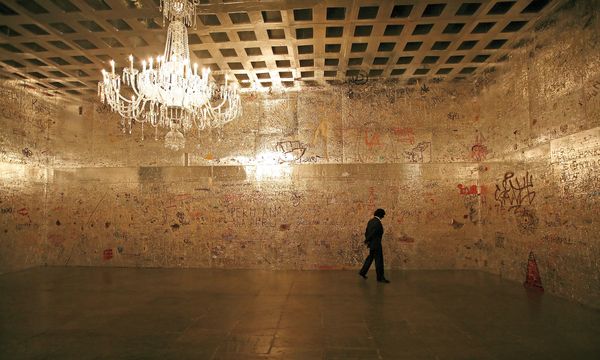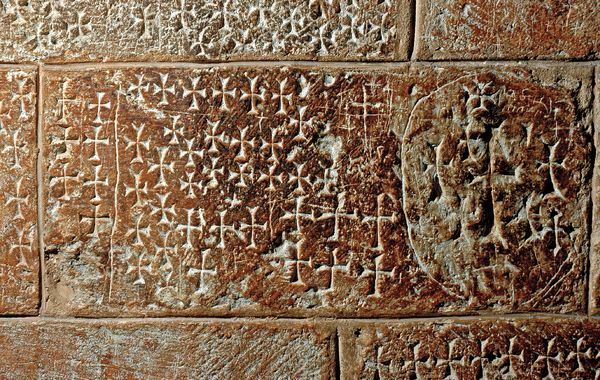Rudolf Stingel Untitled, 2012 © Alessandro Zambianchi, courtesy of the artist
All possible pictures have already been made. The only useful thing left to do, I believe, is to confront yourself with the picture, pushing it almost to the edge of a pit of failure and destruction.
— Rudolf Stingel
An iconic example of Rudolf Stingel's progressive form of opulent abstraction, a result of the artist's experimentation with collective participation, gesture and material qualities, Untitled is one of only twelve panels created by the acclaimed artist in this size. Hailing from Stingel's seminal investigation into graffiti during his iconic installations at the Museum of Contemporary Art in Chicago and the Whitney Museum in New York in 2007, the artist produced the present work by casting panels from the incised gallery walls, electroplating them in copper and sealing them with gold. Demonstrating a continuation of the significant themes of his practice, through the exquisite surface quality of Untitled, Stingel continues to captivate the viewer with his enigmatic and tactile picture surface.
This work from our upcoming 20th Century & Contemporary Art Evening Sale in London belongs to Stingel's celebrated series that originated from those site-specific 2007 Chicago and New York exhibitions. The installations saw Stingel wholly reincarnate the respective gallery spaces, plastering the walls with an expanse of Celotex, a type of easily-malleable insulation paneling. Viewers were invited to scratch, write and mark the pliable and easily punctured surface at will, their individual traces accumulating into a mass of anonymous marks. Exploring the notion of authorship, Stingel physically engaged his audiences allowing the public to become the artist en masse, creating an artwork which captured hundreds of voices. Panels from this Celotex series, including the present work, were electroplated with gold and later re-exhibited at the artist's first solo show at Gagosian Gallery in Hong Kong in 2015. Untitled cements the passage of time as the casting seals off the marks made by visitors to the canvas, ending the work's progressive creation and permanently transforming the random inscriptions into a historical and elevated artwork.
I wouldn't know where to say intervention stops and destruction begins.
Installation view of the exhibition Rudolf Stingel, Whitney Museum of American Art, New York, 2007 © Rudolf Stingel, 2018. Image: Andrea Mohin / The New York Times / Redux
Turning notions of authenticity, hierarchy, meaning and context on their head, the amalgamation of marks and scribbles coalesce into an abstract composition. While the majority of text appears disorientating and unclear in Untitled, the viewer can make out several coherent words and phrases from the canvas, that of 'ANNIE + JOE' scrawled into the lower canvas and 'THEM' more heavily implemented in the upper right corner. It is unclear how much of the work's surface has been reworked and superseded by new graffiti, however, this question is the driving force behind Stingel's multi-layered process. As each individual creates a new gesture, aggregate in rich layers of expression, each mark loses its unique identity and becomes absorbed into a collective mass. The artist explained, as quoted in Francesco Bonami's Rudolf Stingel, Chicago, 2007, "I hadn't planned on this reaction. This abstract shell appeared to be perfect in a provocative way and apparently invited [each individual] to manifest [his impulse]. Numerous motives appear to have led to this behavior; the neutrality of the installation paired with the anonymity of the visitors certainly plays a role. I wouldn't know where to say intervention stops and destruction begins."
Casting Untitled in gold, Stingel transports the spoiled, incised and scribbled surface of the museum walls into an item of elaborate opulence, disrupting our preconceived expectations of this precious valuable medium. Emulating the effect of gold leaf used to adorn Byzantine mosaics or icon paintings, the work metamorphoses into a modern altarpiece and site of devotion. The artist uses the precious material to encase the Celotex, completely disrupting the malleable and tactile properties of the original medium, toying with the spectator's sensory associations. Similarly, the present work invokes the aesthetic of religious graffiti on church walls such as that as seen in the Church of the Holy Sepulchre, Jerusalem. Stingel has previously adopted religious subjects within his work, such as his compilation of black and white paintings of statues of saints which he debuted at Paula Cooper Gallery in New York in 2009. An object of adoration, the present work displays an articulation of the public's discourse, presenting us, the collective, as the deity to be worshipped.
Above: 1) Crusader graffiti on the walls of the stairs leading to the Chapel of Saint Helena, in the Church of the Holy Sepulchre, in the Old city of Jerusalem, Israel 2) Jean-Michel Basquiat Untitled, 1985. Museum of Modern Art, New York © The Estate of Jean-Michel Basquiat. Image: Museum of Modern Art/Scala, Florence
Allowing the public to deface the walls of the respective galleries, Stingel created a space where the forbidden is suddenly possible, creating an opportunistic outburst of visual signs and signifiers. At the same time, the mark-making by the public may also be affected by the possible taboo nature of the drawing act, therefore creating areas of tapered and controlled graffiti which are equally valuable to our nuanced understanding of the public's relationship to hierarchical structures, our collective sense of rules and high art. In the same way that Stingel has captured and catapulted graffiti into the realm of high art, so Jean-Michel Basquiat drew upon the vernacular of graffiti, utilizing Dreyfuss' Symbol Sourcebook as well as literature and popular music references, familiar visual signifiers and pictorial signs to convey a visual language made up of a multitude of sources. The very nature of graffiti is fast and forbidden, conveying the essence of repressed communication in reduced markings. Here, the objectification of Stingel's inclusive and permitted realm of drawing provides a visual springboard for us to observe the primal language which unites us.
Like his artistic forebears, Lucio Fontana, Jean Dubuffet and Yves Klein, Stingel explores the quality of the picture surface, exploiting the creative potential of destruction to give rise to a three-dimensional work that fundamentally demystifies the artistic process. Curator Chrissie Iles argues, as also quoted in 2007 for Bonami's Rudolf Stingel, "Stingel goes one crucial step further; while artists from Klein and Lucio Fontana to Jean Fautrier, John Latham, Piero Manzoni, [Yoko] Ono and Robert Rauschenberg have all destroyed or ruptured the surface of the canvas, Stingel attacks painterly representation by drawing in the entire surrounding space" (Chrissie Iles, "Surface Tension").
Detail of Rudolf Stingel Untitled, 2012 showing 'ANNIE + JOE' inscribed
Having become a significant figure in the New York art scene in the late 1980s, Stingel gained notoriety for his 1989 manual titled Instructions, a self-published artist's book that identifies and illustrates the tools and steps needed to make a painting. Acting as a basis for the present work, through his instructional photographs, like much of his work, the manual explores the essence of making, gesture and expression through questioning authenticity and authorship. Often inviting the audience to interact with his work, Stingel promulgates the artistic process, allowing his artworks to develop as public 'collaborations.' The artist has continued to produce pieces that constantly play with the limitations and restrictions of the process of making art, exemplified in the inclusive nature of Untitled.
Central to Stingel's oeuvre is his palpable rendering of the passage of time, which is exaggerated within the present work through its evident traces of its previous formulation. As Gary Carrion-Murayari wrote for a 2008 exhibition catalogue, "For Stingel, painting is not just representational — it's always relating to materiality and physical change within a temporal space. Stingel's paintings rely on and point out an expanding meaning of time." After exhibiting at the 1993 and 2003 Venice Biennale, Stingel's reputation has continued to flourish alongside his experimentations with new media and new forms of artistic expression. Ultimately, the genius of Untitled lies within the fact that we are viewing a series of isolated, physical memories cast from a collective and public experience.
Participatory in nature and primal in its visual syntax, Untitled presents art at its most inclusive, showing us more about the society we live in with its incorporation of a multitude of viewpoints.




